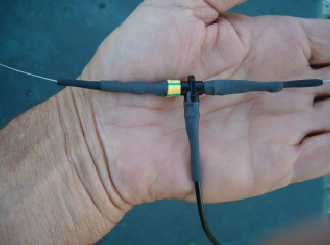
Anything that I am going to backpack into the mountains has to meet certain criteria.
It has to be:
No matter how small and light I build my backpack radios I always have to bring along some sort of photon converter. You know, the thing that turns my high frequency alternating current from the radio into photons and vice versa. You really don't believe in waves, do you?
My current version of portable antennas is constructed of .6 mm. 7 strand stainless steel nylon insulated beading wire. The stuff I am now using cost $6.26 for a hundred foot roll when buying one roll. Super strong. Handles nicely compared to what I have used for wire in the past. Pretty much so small that it is invisible. Support it with 40# rated fish line, feed it with RG-174 type coax. I prefer a dipole arrangement since it seldom requires a tuner and works well for single-band use. I can even use it as an end-fed monopole and use the shield-side as a counterpoise. I just wasn't happy with my center insulators that I tried. Until now.
Browsing through a hardware store on a trip through Oregon I noticed a plastic fitting that just CRIED "center insulator". It's the barbed tee fitting used in 1/4" drip irrigation systems. They come in bags of 10 for around a buck a bag. The ones I have came from Dig Irrigation Products (www.digcorp.com) model # H82A according to the bag.
RG-174 just slips right up inside for a nice fit. I use a #60 PCB drill bit to drill a hole in the fat part of each horizontal barb and another in the material at the very top so that I can slip in a fishing snap swivel when I want a center support. As in inverted-Vee. No need to use a drill, those little bits are easily driven by the thumb and fore-finger which gives you both slow speed and control.Those insulators sport very fine little mold mark lines that indicate the center-lines.
Dress the coax by stripping out enough center conductor to run out to your connection with the antenna wire, solder on some copper wire to the braid and cut the braid close to the jacket. Tack another small piece to the end of the center conductor and use it and the shield lead to thread them up through the center and out each side. Small copper magnet wire lets you steer and push until you can grab it. Use the wire on the shield to electrically connect to the antenna wire, discard the copper wire that you used to pull the center conductor. If you are going to fancy-up the antenna with heat shrink then do not forget to thread on that tubing before you install the insulator. Unless you don't mind sliding it up across the whole length of feedline.

The downside of stainless steel is the inability to solder to it. Don't try. Compression fittings are the way to go. I used some little set-screw type. A bag of a dozen cost $4.39 and are gold-plated copper flat-ended barrels and can be re-used. The wire will slip through twice even with the insulation in place. Fire Mountain Gems Part# A36-1212FX.Measure out your wire, slip on your heatshrink tubing, a compression fitting on each side, and thread the wire through the holes that you drilled in the barbs. It may take a moment to snake it past the fat center conductor wire on the radiator side but it goes pretty easily if you nudge that to one side with a fat toothpick or finger pressure. Loop the wire through one compression bead and clamp it with enough extra lead to work with while connecting to the feedline. Strip an 1/8" or so insulation off the antenna wire end, feed it and the feedline conductor through another bead and clamp it.
I use size #7 brass snap fishing swivels at each antenna end. Makes line handling easy and just clips on to the support lines (which act as insulators, too). Use a clamp bead at each end to secure these swivels. No need to strip the insulation here. Here is where you do the antenna trimming. Which reminds me; Begin with the wire a bit longer than you normally would.

The photos show two steps of heatshrink because the stuff that I have has a low shrink ratio, good stuff will do it in one shot. I used a small band of bright yellow shrink as a marker for which end is connected to the coax center-conductor.
My 40 Meter dipole, with 35 feet of coax, BNC connector, and storage reel, weighs 4 ounces
de ND6T